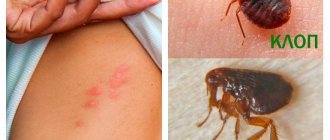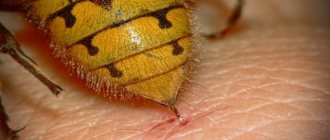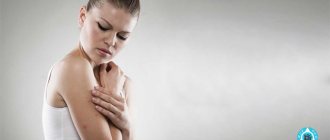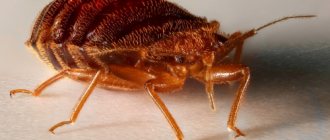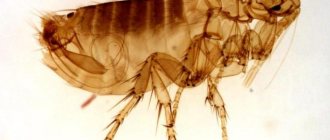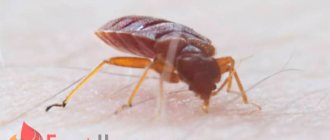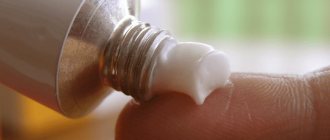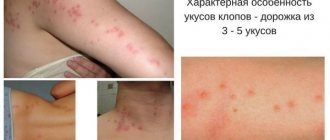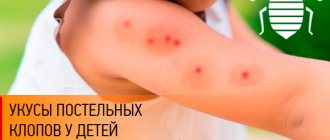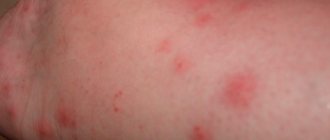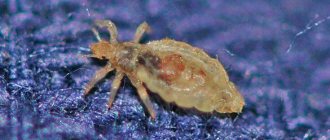The appearance of bedbugs in the house is not uncommon. The current opinion that bedbugs only appear in unsanitary conditions is a myth. They can live comfortably in any conditions. Bedbugs are blood-sucking insects. Blood is needed by female bed bugs to produce offspring, by males for nutrition, and by their larvae for growth and development. Although the relationship between bedbug bites and infectious diseases has not been established, you should not let the situation worse and allow their population to multiply in the apartment.
What do bedbug bites look like?
Bedbugs pierce human skin using their jaws, which are folded into a special elongated proboscis. There are two ducts in the jaws. Through one of them they suck blood from the wound, and through the other they inject saliva, which has a special composition. On the one hand, this structure of saliva does not allow blood to quickly clot, on the other hand, it does not allow a person to feel a bite, so bites can go unnoticed for a long time.
Blood-sucking insects, having attached themselves, can suck blood for up to ten minutes, while neither noise nor bright light can frighten them away. For satiation, they prefer the most vulnerable places on the human body - legs, arms, neck. During one feeding, the bloodsucker can suck up to 1 ml of blood, then it makes the next puncture, moving along the blood vessel. One parasite can make up to 6 bites during the night. Insects usually feed in groups, so after such night feedings, red spots appear, merging into one large spot. About 70% of people do not have any reaction to bedbug bites. But sometimes an allergic reaction to saliva that relieves pain when piercing the skin may occur.
A bug bite looks like this:
- swelling near the bite site. The skin around the affected area swells, the bite itself looks like a small dense lump;
- there is an unbearable desire to scratch the bite site;
- inflammation;
- red spots located in a line next to each other;
- numerous wounds. With a large infestation of bedbugs, up to 500 bites can be seen on a person in the morning.
Consequences
In principle, a bug bite in itself does not pose any particular health hazard. There is currently no evidence that these insects carry infections. However, the consequences can be quite serious: • Individual reactions of the body. In some people, allergic reactions to bedbugs can be severe, which is manifested by the formation of significant swelling, the appearance of a rash, runny nose and other symptoms.
• Possible infection. The results of the “night hunt” of bedbugs cause an itching sensation, which provokes scratching with damage to the skin, and scratches on the skin favor infection. In this case, a serious inflammatory reaction may develop, requiring long-term treatment.
• Psychological trauma. The awareness that insects crawl on your body at night drinking blood does not contribute to restful sleep.
How are bedbug bites different from flea bites?
It is actually difficult to distinguish the bites of these parasites, since the reaction caused by these bites is different for each person. But there are several characteristic features that will help identify these differences:
- Flea bites appear as a depression, framed by a red border and with a hole in the middle. Bed bug bites are red, hard, and slightly raised.
- Fleas leave bites on the human body in different places, they are scattered randomly. The bug bites along the vessel, and therefore its bites are located in a line.
- Most often, fleas leave bites on the legs and ankles. It is very rare to see flea bites on the upper body. Bedbug bites can be found all over the body.
- The similarity between flea bites and bedbug bites is that both cause itching and can sometimes lead to an allergic reaction. There is usually slight swelling at the site of the bite.
You need to know that the rash that appears as a result of bites is not contagious, since these insects are not carriers of dangerous diseases.
How are bedbug bites different from lice bites?
If we consider a separate pimple from bedbug and lice bites, it is easy to confuse them. But if you look at the picture as a whole, you can find differences:
- After lice bites, no obvious chains of wounds remain. A louse, unlike a bug, bites only in one specific place on different parts of the body without any system.
- The swelling and redness after a lice bite is not as pronounced as after a bed bug attack.
- Lice are carriers of pathogens of infectious diseases, which contributes to infection of the wound.
- With numerous lice bites in places where there are most traces of them, the skin acquires a bluish tint.
How are bedbug bites different from mosquito bites?
Mosquitoes, unlike bedbugs, are very easy to detect. Insects are usually active at night. They fly, squeak annoyingly, and bite. If it is more than one mosquito, then there is a very high probability that they will not let you sleep all night. Bedbugs act silently, quietly crawl around the apartment, look for a victim and attack it.
It is not always possible to distinguish bedbug bites from mosquito bites, since they have similar features. For example, unpleasant effects are found on the skin:
- red spots;
- if you comb them, they can increase in size;
- after some time, instead of spots, blisters form, in the middle of which there is a dot of dried blood;
- Swelling may appear in the affected areas.
However, with careful analysis, you can still find significant differences that allow you to distinguish a bug bite from a mosquito bite:
- If you are bitten by a bug, the itching sensation is much stronger. Their bites are arranged sequentially in the form of lines.
- Bedbug bites heal more slowly, and the irritation sensation may remain for several days.
- Bedbugs find open areas of skin with superficial blood vessels to bite. Mosquitoes attack everywhere, and their bites are isolated red pimples or blisters. Bedbug bites can rarely be found in the abdomen, chest, or head. Mosquitoes attack the entire body, from the heels to the head.
- Bed bugs bite secretly and are rarely noticed. In addition, thanks to the special composition of saliva, which temporarily numbs the bite, a person does not immediately feel it. Mosquitoes are easier to detect; they are given out by a specific squeak. And if they attack, the person immediately feels a strong burning sensation and pain during the bite.
- Mosquito bites are dangerous. They are capable of introducing dangerous bacteria into the blood that can cause serious diseases such as plague, tularemia, fever, and HIV infection from an infected person.
First aid for allergic urticaria
The first step is to stop exposure to the allergen if possible. Next, if prescribed by a doctor, you must take an antihistamine (loratadine, fexofenadine, cetirizine). To reduce itching, you can use sunburn cream, and also change to cotton clothes.
Please note: On our portal you can read a detailed article about the symptoms, types and treatment of urticaria
If Quincke's edema develops, low blood pressure, nausea, vomiting, or loss of consciousness, you should immediately call an ambulance.
How are bedbug bites different from allergies?
Every year the number of people who encounter a very serious problem is increasing - an allergy to bedbug bites. Therefore, it is necessary to distinguish the symptoms of an individual reaction to bedbug bites from allergic manifestations. Allergies that arise from bedbug infestation are called chemipterosis. In order to promptly detect the presence of an allergic reaction, you need to know how it manifests itself. In a person who is more susceptible to bedbug bites, a local reaction to the allergen contained in the insect's saliva causes more severe itching, swelling, and redness. Sometimes a general allergic reaction may occur, with the following symptoms:
- irritation, itching, and sometimes urticaria occurs;
- stuffy nose;
- a dry cough appears;
- lacrimation appears;
- eyes turn red;
- Muscle spasm of the bronchi may appear;
- in severe cases, angioedema or anaphylactic shock occurs.
It is not difficult to distinguish allergic manifestations from bedbug bites. You just need to pay attention to their specific signs:
- static. Bedbug bites retain their color and shape for a long time, but allergy symptoms change;
- bite marks are present only on exposed parts of the body and they are located one after another along the same line. Allergic spots are located throughout the skin, and they do not have clear boundaries and outlines;
- the appearance of the skin of other family members. Bedbugs bite everyone who lives in a given living space, so bite marks can be seen on everyone. If redness appears only in one person, then this is an allergic reaction.
Allergy symptoms can be managed with antihistamines. If the case is severe, then it is necessary to seek medical help.
Causes of a mosquito-like rash
When pimples appear, mosquito bites make you itch, which is not always possible to understand. To do this, you need to compare the rash with the usual mosquito and identify inconsistencies.
The problem may lie in:
- Damage to tissues by various blood-sucking insects.
- Allergic reaction to food.
- Prickly heat.
- Infectious pathologies.
- Allergic urticaria.
- Vascular diseases.
- Development of meningococcal sepsis.
Nutritional atopy
Sometimes food allergies resemble mosquito bites. It can occur with any product and in severe situations can even lead to anaphylactic shock.
A distinctive feature of atopy is that pimples appear even under thick clothing and can merge. A food allergy on the skin like the mosquito bites in the photo can subsequently change color, shape, and size. Atopy appears suddenly after ingesting an allergen. If you take an antihistamine, the symptoms decrease. Patients also complain of nausea, vomiting, abdominal pain, and sometimes an increase in temperature.
Prickly heat
Spots on the body similar to mosquito bites may appear due to non-compliance with the thermal regime. Miliaria is more common in infants and is observed in the form of a small rash on the neck, forehead, back, and chest. In severe cases, blisters and purulent rashes form. In this case, the pimples look like mosquito bites.
A distinctive feature is the increase in temperature.
Infectious pathologies
When acne appears, like the skin itches after a mosquito bite, the reason may lie in a number of infectious pathologies:
- Measles. When the virus enters the body, catarrhal manifestations and rashes are observed throughout the body. Subsequently, the spots turn brown. During the incubation period, the temperature may rise significantly.
- Chickenpox. Most often diagnosed in childhood. The rash appears gradually and resembles blisters. There is a clear liquid inside the pimple; if it bursts, it will leave a scar for life. Usually the pathology is mild, but may be accompanied by fever, weakness, and conjunctivitis.
- Rubella. Red rashes have a bump in the middle. The disease progresses with catarrhal symptoms: rhinitis, conjunctivitis, redness of the throat.
- Scarlet fever. The disease occurs with fever, sore throat, and red rashes.
- Molluscum contagiosum. The rash looks like small bumps with a white center inside. They can stay on the skin for a long time without causing any discomfort and are able to go away on their own.
- Roseola. It is characterized by an increase in temperature and the appearance of a pink, raised rash. Papules usually do not bother you and go away on their own in 3-4 days.
Allergic urticaria
It occurs against the background of an allergic reaction to household chemicals, dust, pet hair, and clothing. The rash resembles pink blisters, similar to burns. The patient feels weakness, itching, burning.
Diseases of the blood and blood vessels
Pimples appear in the problem area as if caused by a mosquito bite. In addition, small bluish areas resembling bruises form nearby. Typically, a rash appears when tissue is injured.
Meningococcal sepsis
The patient is concerned about hyperemia and rashes. Symptoms increase rapidly, so immediate medical attention is required. Usually papules are localized on the legs. Over time, they transform into purple subcutaneous spots.
What is the difference between bedbug bites and pimples?
In some cases, there may be doubts about bites. A person may assume that this is not an insect bite, but a simple pimple. But it is impossible to confuse a bug bite with an ordinary pimple. Pimples that appear on the body are of two types - open and subcutaneous. Open pimples are a red swelling with an abscess in the center. When you touch such a pimple, painful manifestations occur. If desired, the middle can be squeezed out.
Subcutaneous pimples have very strong swelling, they are painful, and there is no lesion in the middle. Pimples appear on certain areas of the skin. Most often, where there is a large accumulation of sebaceous glands, since one of the main reasons for their appearance is clogged pores.
Acne can be found on the face, back, neck, and chest. Bedbug bites can also be located all over the body, but they still prefer open areas of the body and most often these are the legs and arms. Pimples appear in random order and it is impossible to track the chain. Acne can appear as a result of some disease, but in this case, other specific signs of the disease must also be present.
Treatment of allergic urticaria
Photo: Rash in the form of insect bites on a man's hand
The action of the allergen that caused the reaction ceases. In addition, the patient should switch to an elimination diet that excludes foods with a large number of allergens (chicken, citrus fruits, nuts, eggs, strawberries, spices, foods with a high content of dyes).
In acute cases of urticaria, antihistamines are prescribed.
In the case of the development of a severe form of the disease, infusion antihistamines, corticosteroids (prednisolone, dexamethasone), calcium preparations that reduce sensitivity to allergens (calcium chloride or gluconate) are used; when the allergen is taken orally, gastric lavage is performed, and activated carbon and other sorbents are also used.
For urticaria, the use of codeine, aspirin, including its derivatives, and ACE inhibitors is prohibited.
How are bedbug bites different from midge bites?
The midge is a small black insect that attacks people outdoors in the warm season. Midges, as a rule, do not fly indoors. Midge bites have some specific features:
- After a midge bite, a slight swelling appears with a dark blood spot in the middle. The appearance of blood is caused by the fact that the insect does not just bite through the skin, it gnaws it out;
- the bite is accompanied by acute pain, to which the person immediately reacts;
- redness and slight swelling form around the blood point;
- A midge bite causes severe itching. The wound itches much more than after a bug bite;
- the bite sites are located in random order, the chain is not built;
- the bite does not go away for a very long time;
- For about seven days, discomfort may occur at the site of the bite.
- Although midges usually attack in groups, they inflict bites individually. Therefore, many bites can be found on a person who was fast asleep in the open air.
Thus, no one is safe from attacks of various kinds of blood-sucking insects. Even if a person does not have such parasites in his own home, he can encounter them in other conditions - while traveling, visiting, or hiking. Therefore, the ability to distinguish the consequences from insect bites will help you respond quickly and protect yourself and family members from possible unpleasant consequences.
Prevention measures
To prevent the appearance of parasites, do this:
- keep the room clean and clean regularly;
- prevent puddles that take a long time to dry up around the house.
If the insects are already infested, rub them with a substance with a pungent odor before going to bed:
- cologne;
- perfume;
- clove essential oil;
- fish oil;
- a mixture of a decoction of edible cloves and cologne (1:1);
- baby cream with added vanillin.
Before going to bed, rub yourself with cologne.
Pests rely on their sense of smell to find prey. An unfamiliar smell will disorient them or scare them away.
Mosquitoes are destroyed using special devices:
- fumigator;
- insect killer.
The second device is equipped with an insect-attracting ultraviolet lamp and a metal grille, which is supplied with high voltage.
